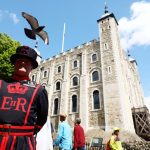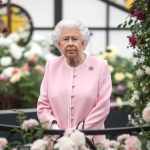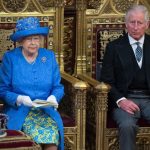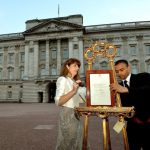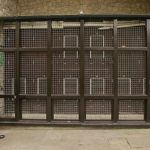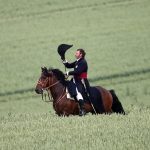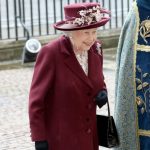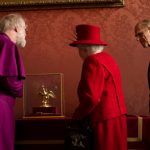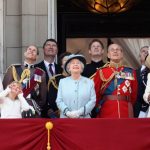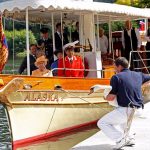Unusual royal traditions
 10 unusual royal traditions you never knew existed
10 unusual royal traditions you never knew existed
By Meghan Jones, Reader’s Digest From Business Insider
Each year, the royal family gathers on the balcony of Buckingham Palace for Trooping the Colour in honor of the queen’s birthday. Getty Images
Royal weddings and births are all over the news, but there are some royal family traditions and ceremonies that you might not know about.
When making her next pick for High Sheriff, the queen marks his or her name on a list with a bodkin.
The Parliamentary “year” officially begins in May, but not until the queen says so.
When it comes to royal occasions, weddings and births usually garner the most attention. But there are plenty of other lesser-known ceremonies and goings-on that have cemented their place in the British royal tradition.
Trooping the Colour
Trooping the Colour is a part of the queen’s birthday celebration. Chris Jackson/Getty Images
You’ve probably heard about the Changing of the Guard, but that’s not the only major royal ceremony the Queen’s Guard participates in. Every June, as part of the Queen’s birthday celebration, the uniformed guards parade along the Mall in London. Fourteen hundred guards strong, the parading soldiers are accompanied by 200 horses and 400 musicians to create a massive patriotic spectacle. This ceremony actually started not as a celebration but as a military ritual; “trooping the colour” was originally a way to ensure that the British soldiers knew who was on their side in battle. Back in the 17th century, the regimental flags (the “colours”) were paraded by them every morning so that the soldiers could recognize the colors of their own regiment. Since 1748, though, it’s been part of the sovereign’s birthday bash. Learn why Queen Elizabeth technically celebrates two birthdays.
Opening of Parliament
Queen Elizabeth II and Prince Charles. Stefan Rousseau/WPA Pool/Getty Images
In England, the Parliamentary “year” officially begins in May, and not until the Queen says so. Though the State Opening of Parliament is a fairly simple government occasion, it’s still marked by an elaborate ritual, in true British monarchy fashion. The Queen travels to the Palace of Westminster (separately from the Imperial State Crown and regalia, which arrive in their own carriage). In the Palace’s “Robing Room,” she is bedecked in the crown and robe. From there she leads a procession into the chamber of the House of Lords to deliver a speech to both Houses of Parliament. Only after the Queen’s speech has ended can the new year of lawmaking commence.
Perhaps the oddest part of this ceremony is when a House of Lords official known as “the Usher of the Black Rod” has the door of the House of Commons chamber intentionally slammed in his face. This part of the ceremony represents the way the Commons is independent from the monarchy. Here are some more things you didn’t know Queen Elizabeth II had the power to do.
Ceremony of the Keys
The Tower of London. REUTERS/Neil Hall
At the Tower of London, this lesser-known ceremony takes place every single day—and has for the last 700 years! Originally a security measure, this ceremony has evolved into simply a matter of tradition. Every night at 9:53 p.m., the Chief Yeoman Warder, accompanied by an escort of Queen’s Guardsmen, walks around the Tower securing all of the gates. When the Warder arrives at the Bloody Tower, a sentry asks, “Who goes there?” The Warder confirms that he has the Queen’s keys, and the sentry tells him to pass. The exchange is identical every single night. Its longevity makes it one of the world’s oldest military ceremonies.
Only once was there so much as a delay to the proceedings: During World War II, a bomb from an airstrike fell near the Tower, and the blast knocked over the Warder and his escort. They were unharmed and continued with the ceremony, even sending a letter of apology to King George VI for the tardiness of the ceremony. (He replied that a bombing was an acceptable excuse.)
Swan Upping
Queen Elizabeth co-owns all unmarked mute swans in the United Kingdom. WPA Pool/Getty Images
Since the 12th century, the mute swan has been a symbol of the British monarchy. Back then, this type of swan (so called because it doesn’t make as much noise as other types of swans) was considered a delicacy. If people who were not part of the monarchy wanted to own a mute swan, they had to pay a massive amount of money to have a mark put on its beak. Back then, the crown would take stock of which swans were theirs, ensuring that the monarchy had the exact number of swans the sovereign requested.
Today, luckily, mute swans are no longer used for royal meals, and the ceremony instead encourages the conservation of the species. Dressed in red, a team of “Swan Uppers” rows along the Thames River every July and tallies up all of the mute swans they see. They also assess the birds’ weight and check to make sure they’re in good health. Learn about the full history of the British monarchy’s feathered friends.
The royal-baby easel
The queen is the first person to hear about the birth of a royal baby. AP Photo/John Stillwell, Pool
The first person to learn of a new young royal’s arrival to the world must be the Queen. But when it’s time to share the news with the world, out comes the ceremonial golden easel. When Prince Louis was born in April 2018, a notice announcing his birth was displayed in front of Buckingham Palace, on the same easel that announced his father Prince William’s arrival in 1982. Historically, the notices were handwritten, but today they’re typed out with the time of birth penned in.
Of course, in today’s world of social media, there are more efficient ways to spread the baby news than a paper on an easel, but we still don’t think this tradition will be going anywhere anytime soon! The easel announcement is usually concurrent with an electronic one via Twitter. And, of course, there’s the unofficial Town Crier, who announces major royal events despite his complete lack of affiliation with the royal family. Learn about some more unusual royal jobs you had no idea existed.
Raven soldiers
Legend has it the Tower of London will collapse and the kingdom will fall if all the ravens leave. Scott Barbour/Getty Images
Since the reign of Charles II in the 1600s, the Tower of London has always been home to no fewer than six raven guardians. During Charles’s reign, the royal astronomer complained that the Tower of London’s avian visitors were interfering with his research. The King ordered that the ravens be killed, only to be told by a superstitious courtier, “If the Tower of London ravens are lost or fly away, the Crown will fall and Britain with it.” It may seem like nothing more than a dated superstition, but even still, the monarchy doesn’t dare challenge it.
Today, seven ravens reside at the Tower, living on a diet of raw meat and birdseed biscuits. Just like regular soldiers, the ravens can be dismissed for misbehaving. One raven, named George, had his status revoked recently because he had a habit of eating television antennas. Here are some more of the most bizarre superstitions of the royal family.
Waterloo Ceremony
A historical re-enactor playing the role of the Duke of Wellington takes part in the first part of a large scale re-enactment of the battle of Waterloo. Carl Court/Getty Images
Every year, the monarchy celebrates the historic British victory at the Battle of Waterloo by… having the Duke of Wellington pay rent. It was the first Duke of Wellington who, on June 18, 1815, led British forces to victory against Napoleon. As a thank-you, the crown purchased a house in Hampshire for him. Eight Dukes later, the person holding this position still resides in Stratfield Saye House. On June 18 of every year, the Duke of Wellington commemorates the Waterloo victory by paying “rent” for the house—but it’s not money. It’s a purely symbolic transaction, during which the Duke gives the Queen a silk-embroidered French flag. In the Guard Chamber at Windsor Castle, the flag is draped over a bust of the first Duke of Wellington.
Her Highness the Duke
The title dates all the way back to 1265. WPA Pool/Getty Images
Of Queen Elizabeth II’s many titles, the most head-scratching might be the Duke of Lancaster. Yes, Duke, not Duchess. How did the female Queen of England get this title? Well, the title dates all the way back to 1265, when King Henry III and his wife bestowed over 18,000 hectares of English and Welsh land upon their son, who became the Earl of Lancaster. This title would eventually become “Duke of Lancaster,” and since 1399, each new reigning monarch has inherited both the land and the title.
When the title became Queen Victoria’s, she declared that she thought “Duke” should be the title even if it was a woman holding it. Since, historically, “Duke” was an inherited title while “Duchess” usually just went, by default, to the wife of a Duke, Victoria preferred the former title. So “Duke of Lancaster” remained a gender-neutral title, and today, the Queen still doubles as a Duke. Check out some of the wackiest gifts the royal family has ever received.
Pricking the bodkin
When making her next pick for High Sheriff, the queen marks his or her name on a list with a bodkin. Chris Jackson/Getty Images
The title of High Sheriff—a ceremonial officer that presides over a county in Great Britain—has been around since the time of the Anglo-Saxons, so sure enough, there’s an odd tradition or two associated with it. The way the Queen appoints the new Sheriffs, in particular, is a little on the bizarre side. When making her next pick for High Sheriff, the Queen marks his or her name on a list—not with a writing utensil, but with a bodkin, or a fancy hemming needle.
One theory for the origin of this tradition suggests that Queen Elizabeth I was asked to make her High Sheriff picks while embroidering. Without a pen nearby, she reached for the bodkin to indicate her choices. Another theory suggests a more practical reason: Piercing the list of names with the sharp bodkin made a permanent mark on the paper, while ink could be tampered with if someone didn’t approve of the choices.
The Coronation Spoon
Queen Elizabeth II is shown the Ampulla and Coronation Spoon, which was used at her Coronation in 1953. Matt Dunham/WPA Pool/Getty Images
When is a jewel not a jewel? When it’s a spoon. This is the case for the oldest of the Crown Jewels: The Coronation Spoon. Royal records of the spoon, which is made of silver with gold trim, date back to 1349, and even back then it was considered an “antique.” The year 1603 was the first time the spoon was featured in a royal coronation ceremony; it was used to anoint the new king, James I, with oil.
The spoon is one of very few royal items that’s survived from medieval times; after Oliver Cromwell helped overthrow the monarchy in 1649, he had nearly all of the royal regalia melted and destroyed. Luckily, though, he opted to sell off the spoon instead, and the buyer returned it 12 years later, just in time for the coronation of Charles II. Today, the 700-plus-year-old spoon still features in every royal coronation ceremony and maintains its place in the Tower of London with the other jewels. Next, learn the etiquette rules every member of the royal family must follow.
Sign up here to get INSIDER’s favorite stories straight to your inbox.
Read the original article on Reader’s Digest. Copyright 2018. Follow Reader’s Digest on Twitter.
For more on this story go to: http://www.businessinsider.com/unusual-royal-traditions-and-ceremonies-2018-7?utm_source=feedburner&%3Butm_medium=referral&utm_medium=feed&utm_campaign=Feed%3A%20businessinsider%20(Business%20Insider)

